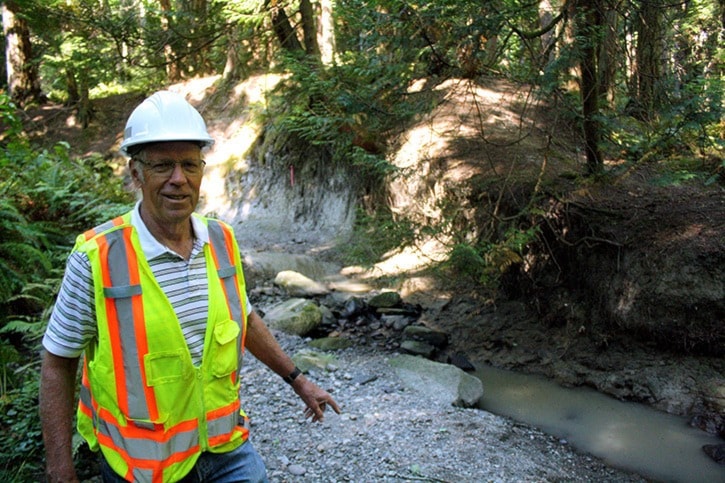Darrell Wick walks briskly along a temporary mulch road in Mt. Doug Park, as small pink flags demarcate the narrow drive through western red cedar, Pacific dogwood and Douglas fir roots.
As Douglas Creek appears over a fern-covered slope, a mammoth digger delicately piles boulders and tree roots along the edges of the eroded creek bed.
“There were huge storm surges that washed out all the beds and basically destroyed the creek over a number of years,” says Wick, pointing to slick, grey clay and muddied puddles full of water striders surrounding the digger.
“In a week from now, you’ll never know this equipment was even here,” he says.
As president of the Friends of Mount Douglas Park Society, Wick is overseeing a five-year plan to restore Douglas Creek to its former glory as a salmon-bearing stream. The project, now in its third year, is being supported by Saanich Parks as well as the Pacific Salmon Foundation and has a one-month window in which to complete the work each August. There are two end goals: to stop erosion and to make the creek bed appealing to returning chum and coho salmon and cutthroat trout.
“Originally, this was salmon-bearing when Gordon Head was farmland,” Wick says. “We’ve had some salmon return in the last number of years, but we want to improve that.”
As Gordon Head became urbanized with impervious surfaces like roadways and rooftops, the water no longer soaked into the ground but instead was funnelled directly into Douglas Creek through stormwater piping. The creek’s sole water source today is stormwater runoff, a fact that often leads to poor water quality after a summer dry stretch.
“We’re going to be increasing the weir at the top of the creek,” Wick says. “The sediment will sink, while floating oil pollutants are dammed there and can be skimmed off.”
Dry roots protrude from walls of the creek bed, leaving areas of the ancient tree canopy vulnerable to collapse. The rock and wood will protect those at-risk trees while redirecting the creek flow.
“Those tree roots also provide a hiding place for the salmon,” Wick says.
Biologist Dave Clough hoists himself up from the creek with a large wooden stick, his boots muddied.
“The idea is we’re trying to mimic the function of old-growth tree roots on banks that don’t have trees anymore,” says Clough, who is overseeing the multi-year project. “For thousands of years, the creek was only so wide, and the Douglas fir and red cedars grew to that limit. We logged the watershed and paved it, then the highest water patterns became hundreds of times what they were before.”
Mount Doug Park (PKOLS) is one of the last remaining natural riparian climates with ocean connectivity on southern Vancouver Island, says Clough, arching his neck to look up at the robust trunks around him.
“There were streams everywhere in Greater Victoria, they were put in pipes, look at Bowker Creek,” he says.
“This is the last best that we have.”
Once the creek is restored, Clough envisions Douglas Creek as a thriving micro-climate for otters, mink, salmon, herons, hummingbirds and other wildlife.
Also key is preparing for storm water surges by installing rain cisterns, rain gardens and other water capture methods at the source.
“This forest is so healthy down here that it takes care of itself, the invasive species have a much harder time getting a foothold,” Clough says.
As Wick climbs through the native vegetation and follows the path back to his nearby home, he reflects on the impact of his ongoing work for the next generation.
The Friends of Mount Douglas Park Society co-ordinate events like fry releases each spring in partnership with local schools, as well as the annual salmon toss to raise stewardship awareness.
“It’s a Canadian mentality that there’s endless wilderness, and there isn’t,” Wick says.
“This park is right inside the city, and that’s what makes this so special.”
editor@saanichnews.com
